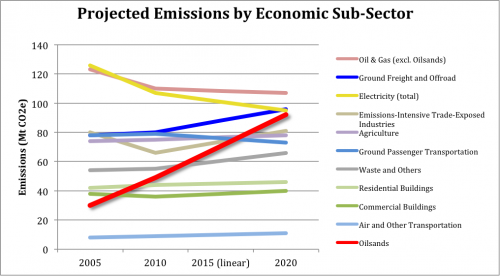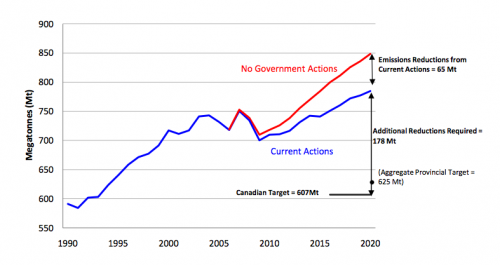Anyone who works on climate change policy in Canada, like I do, ends up talking about the oilsands on a daily basis.
The massive development reshaping parts of Alberta's landscape attracts criticism like no other project in Canada, and those concerns don't stop at our borders.
But as its public profile has grown, some have argued that the oilsands sector is being unfairly singled out. After all, the oilsands account for less than seven per cent of Canada's total greenhouse gas pollution — far less than the emissions from coal, transportation or heating our homes.
In our work at the Pembina Institute, we're sometimes asked to justify why we put so much emphasis on one relatively small piece of Canada's emissions puzzle.
For my colleagues in Alberta, the answer to the question "why do you spend so much time on the oilsands?" might involve water, caribou, the consequences of an overheated economy or the local air pollution. But I work on the federal government's climate policy in Ottawa, so the oilsands matter to me because of what they mean for Canada's approach to tackling climate change.
Oilsands as outlier
No one could make the case about why the oilsands matter better than Environment Canada just did. In late July, the department published a document called Canada's Emissions Trends, which provides an up-to-date projection of greenhouse gas pollution under a "business as usual" scenario — in other words, our emissions future unless governments take stronger actions than they have to date.
This document provides really important data, so we were very glad to see it made public. But the picture it paints of where oilsands emissions are heading is — to put it mildly — not pretty.
Over the last two decades, greenhouse gas emissions from the oilsands have grown by over 150 per cent. From 2005 to 2020, Environment Canada's number show, they're going to keep right on growing, tripling from 30 million tonnes in 2005 to 92 million tonnes in 2020. That represents 12 per cent of Canada's projected national emissions in 2020, more than the total for any province except Alberta and Ontario.
That makes the oilsands sector very unique. In other parts of Canada's economy, emissions are expected to grow much more slowly, or even to drop as technologies improve or federal or provincial emission reduction policies take effect. Most notably, electricity emissions are expected to fall by 31 million tonnes in Canada by 2020 in the absence of new government policies — while oilsands expansion is forecast to increase emissions by twice that much over the same period. (It's worth noting that the federal government has already outlined a regulatory approach to coal-fired electricity detailed enough that it's been included in Environment Canada's "business as usual" projections, while the projections don't include an equivalent federal policy approach for the oilsands.)
Overall, Canada's emissions are projected to increase by 54 million tonnes between 2005 and 2020 (Table 3, page 22). Emissions from the oilsands (including emissions from upgrading) are projected to grow by 62 million tonnes over the same period (Table 5, page 25). Because the ups and downs in emissions in other sectors largely cancel each other out, the bottom line is that virtually the entire projected increase in Canada's emissions between 2005 and 2020 will come from the oilsands.
Figure 1, below, shows what this looks like; the oilsands are the red line.

From 2005 to 2020, the oilsands are projected to be responsible for 388 per cent of the increase in industrial emissions. (In other words, from 2005 to 2020 the oilsands are projected to grow nearly four times more than Canada's industrial emissions as a whole.)
Clearly, the oilsands sector is a real outlier.
If that projected oilsands growth does take place, it's going to make hitting Canada's 2020 emissions target very, very difficult. Worse, we're starting from a position of weakness even before that extra oilsands growth takes place: all of the current announced federal and provincial climate policies cover just one quarter of the gap between our projected 2020 emissions and our 2020 target. Environment Canada's chart showing the gap between our policies and our target is shown below as Figure 2 (in Canada's Emissions Trends, it's Figure ES3, page 12).

If we do miss our target in 2020, emission growth in the oilsands will probably be a big part of the reason.
But the oilsands' influence doesn't seem to end with their direct impact on Canada's emission profile. Over the years I've worked on climate policy, I've become more and more concerned about the disproportionate weight that this small but mighty slice of Canada's emissions seems to be exerting on our government's overall approach to global warming.
What growth means
As a thought experiment, let's assume that Prime Minister Harper's government wants to see the oilsands continue their rapid growth indefinitely. What would that mean for his climate policy?
For starters, he would need an approach that allows for increases in emissions from the oilsands, at a time when climate science tells us that overall greenhouse gas emissions from countries like Canada need to be dropping quickly.
To reconcile growth in the oilsands with Canada's target of cutting emissions by 2020, the government could ask other sectors to pick up the slack. (In the case of regulations, that means tougher standards in other sectors so that absolute emissions fall; if we're talking about a price on emissions, it means a higher price than the non-oilsands sectors would otherwise need.)
Pity the poor federal environment minister who has to convince Québec's manufacturing sector or B.C.'s forestry sector that they need to make deeper cuts to allow the oilsands to pollute more. Even the most determined environment minister might retreat from that prospect.
If he or she did back down, the government's most likely fallback position is to drop the idea of capping pollution altogether and resort to intensity targets, which are also known as performance standards. For the oilsands, that would mean targets set in emissions per barrel of oil, not in absolute greenhouse gas emissions.
But if oil production keeps growing rapidly, real pollution will keep rising, even if each barrel becomes cleaner. (In fact, that's exactly the trajectory we've seen in the oilsands since 1990.)
The currency that matters to the environment is absolute emissions over time, and intensity targets for the fast-growing oilsands almost certainly mean that the oilsands sector's emissions won't drop anytime soon. That wouldn't necessarily be a problem if other sectors, or other parts of the economy, were going to pick up the slack — but as noted above, that's a hard case to make to either other industry sectors or to Canada's consumers.
What is the likely result of weighing these political tradeoffs? One option would be to show real leadership by adopting policies strong enough to hit our target. But in a world where the oilsands are encouraged to keep growing, a more likely result is that their "needs" set the bar — a low one — for the rest of Canada's industrial sectors.
In the real world, intensity targets for all heavy industry sectors is exactly what every federal government climate plan in Canada (Liberal or Conservative) has proposed. Each time, environmentalists dismiss the plans as flawed as soon as they're announced; so far, none of those plans has actually gone into effect.
It looks like we're now stepping back on to the same merry-go-round for one more ride. Environment Minister Peter Kent says he plans to set intensity targets for the oil and gas sector, although he has yet to provide any details about the timing or design of these regulations.
Crossing the border
The oilsands' long shadow isn't just visible in Canada's domestic climate policy; instead, it has crept across our borders to shape our foreign policy too.
It's well known that the emissions produced by separating oil from sand make the resulting product "dirtier" from a climate perspective, than conventional oil produced in North America. So if other countries start choosing cleaner fuels over dirtier ones, the oilsands' product could lose out to lower-emission competitors.
To a government that wanted the oilsands to keep expanding as fast as they possibly could, policies that required other countries to clean up their fuels wouldn't be considered environmental victories. Instead, those policies would represent potential threats to the oil industry's export market.
I wish this were only a hypothetical risk, but it's not. Through Access to Information requests, our organization and others have documented attempts by Canadian officials to undermine policies supporting cleaner fuels in the U.S. (in Washington and California) and the EU, arguing that oil from the oilsands deserves to be treated the same way as any other oil. They don't do this alone: the Government of Alberta is engaged in the same game, and of course, so are some oilsands companies and lobbyists.
Taking a different road
Imagine if we had put our eggs into a different basket. Instead of pouring billions and billons of dollars into tar, picture a Canada that had invested in engineering, manufacturing and selling solar panels.
Rather than fearing the green choices other countries make, we would celebrate them. The more jurisdictions decided to tackle climate change, the more potential customers our solar panel makers would have to sell to, and the more engineering and sales jobs we create. In fact, our government might decide to take on more ambitious action at home as a means of leading by example. If we inspired others to follow suit, we'd increase our solar panel profits.
In Canada's solar-panel-driven economy, good climate policy wouldn't just be the right thing to do; it would also become a premiere way to enhance Canada's competitive advantage.
Recent choices by the federal government suggest that it sees oil, not clean technology, as Canada's economic ace in the hole. That would explain Ottawa's decisions to support carbon capture and storage technology — which aims at allowing fossil fuel production to reduce its greenhouse gas emissions — while cutting back on federal investments in renewable energy and energy efficiency.
A risky bet
At a time when U.S. lawmakers face tough obstacles in any attempt to reduce greenhouse gas emissions, Canada's oil-friendly stance might seem like the most rational option.
(Of course, failing to take ambitious action to tackle climate change is far from "risk-free," even from the perspective of allowing more oilsands expansion. For example, in its consideration of the proposed Keystone XL pipeline, the U.S. Environmental Protection Agency has asked for more information about the Government of Alberta's plans to reduce greenhouse gas emissions from the oilsands. If Alberta had better news to share about its effectiveness in cutting those emissions, its chances of persuading U.S. decision-makers to allow the pipeline to proceed would almost certainly improve.)
But over the years to come, increasing our economy's reliance on the oilsands amounts to making a very risky bet that the rest of the world won't take meaningful action on climate change.
If that bet proves to be correct, we can keep on selling oil to our American neighbours (and perhaps to other markets) as long as we want, and the only risks we face are the potentially devastating consequences of global warming itself — that, and continuing a Canadian tradition of never reaching our emission targets.
But if we bet on the wrong side, and other countries do make the shift to clean energy, the pitfalls are potentially massive.
All the capital that companies have sunk into the oilsands (and that Canadian citizens have supported through tax breaks to oil development) would suddenly look like a dead end.
Rather than selling China our oil, we could face a future where we're buying their state-of-the-art electric cars.
Breaking the resource curse
There's a concept in economic literature called the "resource curse," which refers to the negative effects that the discovery of natural resources like oil can have on a country's economy and government.
"Through their direct emissions and their far larger influence on Canada's overall emissions policy, you could argue that the oilsands have stunted and disfigured Canada's approach to climate change."In Canada, rising concern about climate change over the last two decades has coincided with a massive expansion of development in the oilsands. It's not hard to make the case that this expansion has been a curse instead of a blessing for Canada's climate policy. Through their direct emissions and their far larger influence on Canada's overall emissions policy, you could argue that the oilsands have stunted and disfigured Canada's approach to climate change.
That's a harsh assessment, and we don't make it to lay blame on any one group. It's an accident of geology that Alberta got the oilsands instead of, say, Germany. Energy companies are doing exactly what the system allows and encourages: developing a valuable resource, generating returns for their shareholders, and largely following the environmental rules Canada and Alberta have set. Some companies even go well beyond the minimums that those rules require.
A role for all of us
If you talk to oilsands companies, you'll often hear that individual Canadians can and should do more to tackle climate change. I agree wholeheartedly. We can drive our cars less and choose more fuel-efficient models. We can vote for politicians who care about the environment and promise a shift to cleaner energy. We can accept that some things will cost more as a result of making that shift, but we can decide that it's worthwhile to pay extra for things we really value, like a clean and safe environment for our children.
So there's an important role for all of us as consumers and as citizens. But we shouldn't have to solve climate change alone: we need governments and companies to do their parts too.
Right now, the list of oil-exporting countries with strong climate policies is very, very short — so Canada's federal and provincial governments are certainly not alone in failing to square the circle of producing oil and cutting emissions.
But Canada is a successful G8 country, one with more than enough wealth, talent and ingenuity to do so much better.
At the Pembina Institute, we've spent a decade proposing solutions that would allow Canada and Alberta to manage the oilsands more responsibly. We've made concrete and practical suggestions that would lead to better environmental performance on air, water, land management and monitoring. In order to reduce greenhouse gas pollution, we're calling for Alberta to adopt science-based emission targets (and plans to meet them); a strong and growing price on greenhouse gas pollution; and regulations that require the use of technologies like carbon capture and storage where appropriate.
For Canada's climate policy as a whole, the bottom line is really simple: we can't keep letting one sector's overheated growth steal the show. Climate policy has to be designed to meet Canada's greenhouse gas targets in the smartest and most efficient way possible — and that means all of us, oilsands included, have to do our share.
It's not too much to ask. And if we're going to have any chance of tackling global warming, it's the least we can do.
Clare Demerse was the director of federal policy at the Pembina Institute until 2014.



